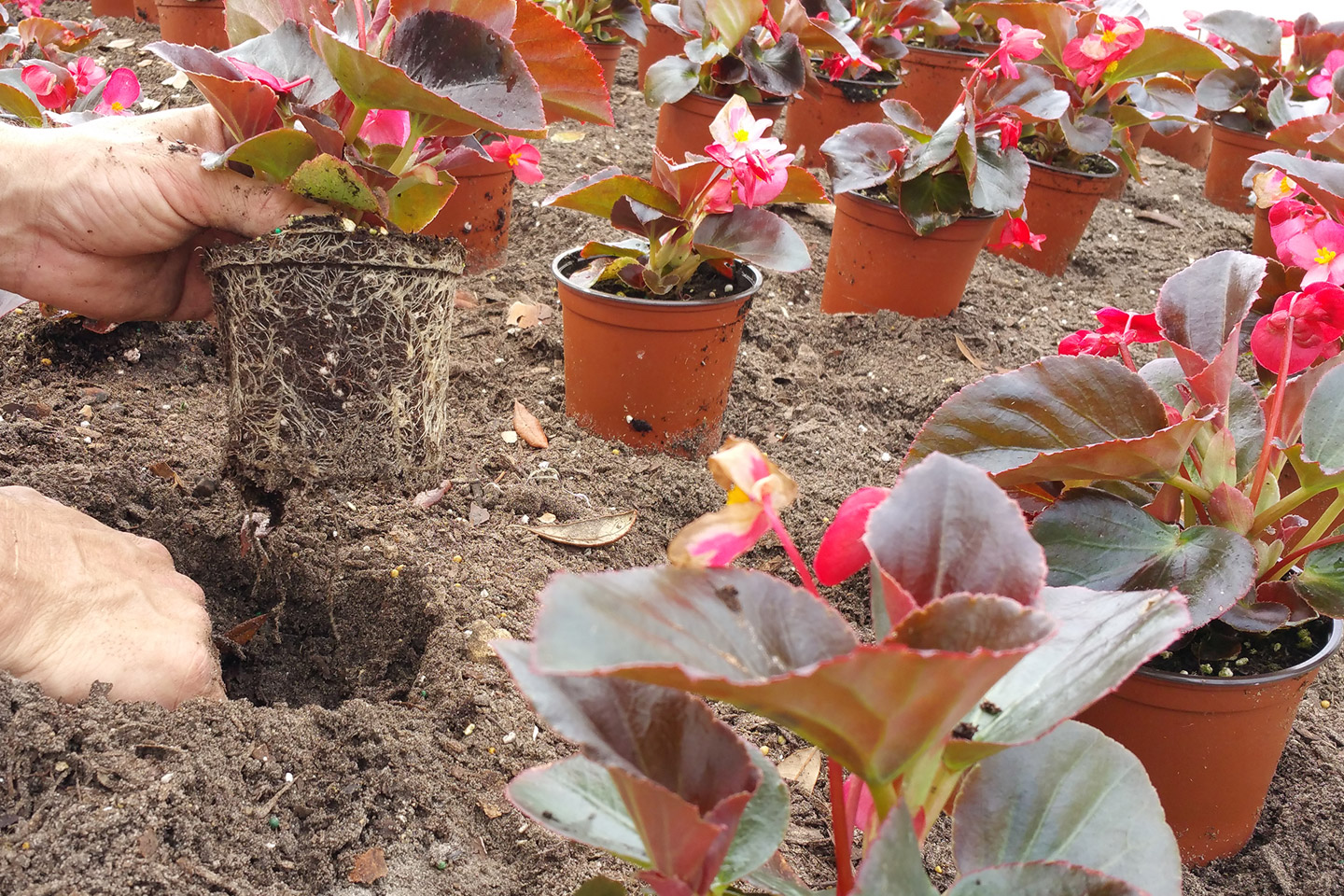Transitioning from the Wet Season to the Dry Season in Florida: A Landscape Evolution - Sit Down with CEPRA
Florida's landscape is a dynamic tapestry, deeply influenced by the state's distinct seasonal rhythms. As we transition from the wet season to the dry season, the landscape environment undergoes significant changes. These shifts not only impact the flora and fauna but also the very character of the landscape itself.
Our Florida weather can be one of extremes from droughts to hurricanes — sometimes occurring in the same year! Our state has two seasons: the wet season, when 70 percent of the year's rain falls from June through October, and most hurricanes occur; and the dry season, from November through May.
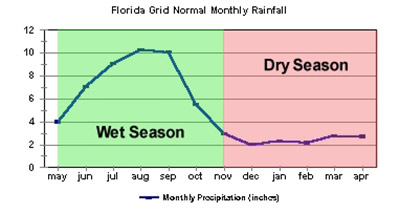
Florida Seasonal Rainfall
The Wet Season: A Period of Abundance
During the wet season, Florida experiences a substantial influx of rainfall, often in the form of daily afternoon thunderstorms. This period is marked by lush growth in the landscape across the state. Water bodies such as lakes, rivers and wetlands swell with the increased precipitation.
- Vegetation Growth: The wet season's ample rainfall promotes new rapid growth in our landscapes.
- Flooding and Hydrology: The high-water levels can lead to pooling water and flooding in low lying areas and regions with poor drainage. The overabundance of water can additionally promote increased pest and disease presence in the landscape.
Our wet season typically resembles "summer" across much of the remainder of the country. With the primary difference being that the heat and humidity are relentless. Though it does not rain every day during the summer, the frequency of rainfall usually begins to increase in late May. We typically receive an abundance of rain, about 52 inches a year, falling mostly in the wet season. At times the start of the wet season can occasionally be delayed until June and in rare cases, even can occur as late as early July.
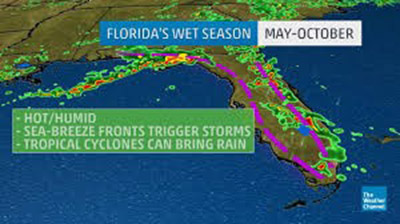
Florida's Wet Season
The Dry Season: A Time of Contraction
As Florida transitions to the dry season, the landscape begins to contract and change. Rainfall diminishes, and the daily thunderstorms cease, leading to a marked reduction in water levels across the state.
- Vegetation Changes: With the decrease in water, most of the landscape will adapt to drier conditions. However, there are exceptions within the landscape that will require the thoughtful management of your irrigation system.
- Fire Season: The dry season in Florida also coincides with the peak of fire season. The reduction in moisture makes the landscape more susceptible to wildfires, which can be ignited by lightning or human activity. These destructive fires play a crucial role in maintaining Florida's ecosystems particularly in forests and prairies where the fire helps to clear out underbrush and promote new growth.
- Water Conservation: As water levels drop, both natural ecosystems and human communities must conserve water. In Florida, water restrictions are in place as to the day and times that you can irrigate the landscape.
Technically speaking, many folks consider October to be the start of Florida's dry season. While the rain starts to let up around October, our soil is still moist, and plants are slowing down for the upcoming season. The dry season is marked by cold fronts that sweep through the state from late fall through early spring, ending the almost daily afternoon thunderstorms of the summer. However, the transition from wet to dry can be complicated by tropical systems that can bring periods of heavy rain through November.
Cold fronts continue to push through the state during the traditional "meteorological winter" months of December, January and February. The occurrence of rainfall is much less frequent than experienced in the summer months. The greatest coverage of rainfall during the winter months often occurs when one of these cold fronts moves back northward as a warm front.
Late February through March is the time-period that most closely resembles typical Spring weather. Large swings in temperatures often occur along with occasional severe weather episodes, but rainfall continues to be infrequent. April is often the driest month of the year as fronts become weaker and yield less rainfall but manage to pass through the state and reinforce the seasonal dry air mass. Temperatures will begin to increase through May leading to June and the rainfall frequency will increase as compared to April.
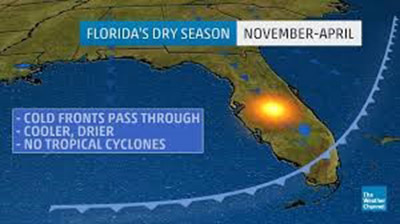
Florida's Dry Season
Tips for Watering
When we irrigate, we want to replace the water that has been lost due to evaporation and transpiration (through plants), which is termed "evapotranspiration." When water is depleted from the soil due to evapotranspiration the soil becomes drier and should trigger an irrigation event to get it back to near field capacity. Field capacity is the amount of water in a soil that has the most plant available water after it is drained from gravity.
In the dry season, watering your landscape once per week with 3/4 inches of water should be sufficient for maintaining an established landscape. This amount of water should saturate the top 9 inches of typical sandy Florida soil. By watering weekly to this depth, you will train your turf grass and plant material to grow deeper roots, increasing their drought tolerance. Do not water between the hours of 10 am and 4 pm. These are the hottest times during the day where we would lose the most water to evaporation before getting it to the turf grass and plants.
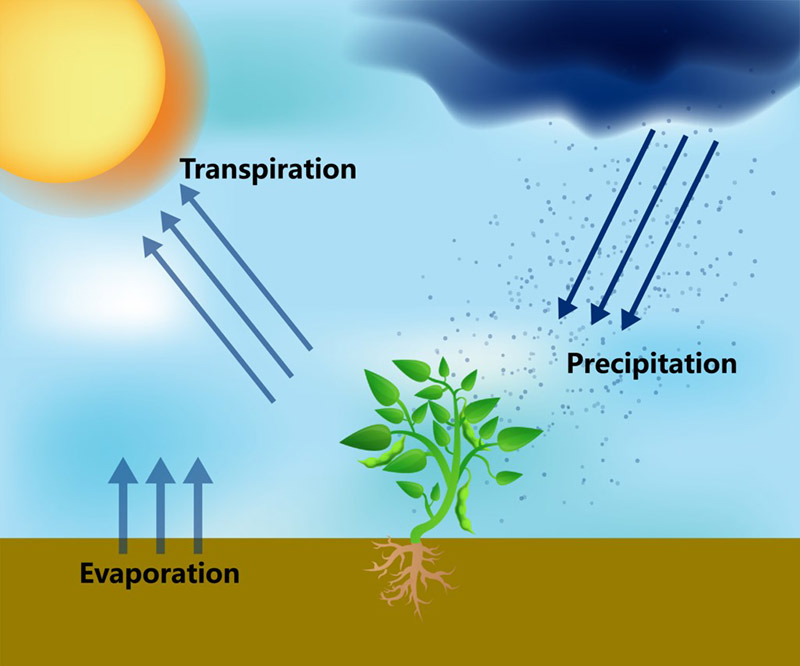
Evapotranspiration Diagram
On weeks with sufficient rainfall, you can skip your weekly scheduled irrigation. Overwatering is inefficient and can promote weeds and diseases in your landscape. Monthly irrigations system checks are a must to take care of leaks and breaks, making the necessary repairs to maintain the system at its optimum efficiency while preventing your water bill from increasing due to water waste.
In Florida our water restrictions change in the spring and fall, when daylight savings time begins and ends. In our dry season the outdoor watering is limited to one day per week from the first Sunday in November to the second Sunday in March and during our wet season the outdoor watering is limited to two days per week from the second Sunday in March to the first Sunday in November. Some areas in Florida have stricter water restrictions in place due to water shortages so check with your local city and or county for your current restrictions.
Conclusion
The transition from the wet to the dry season in Florida is a profound event that reshapes the management of the landscape. It is a period marked by both challenge and opportunity, where the landscape adjusts to changing conditions and where human actions play a pivotal role in maintaining the delicate balance while being stewards of proper water use in our Florida landscapes. Additionally, while understanding that Mother Nature isn't always typical, and she does not always exactly follow the wet/dry calendar with this knowledge we know that we can expect two seasons in Florida, and we can be prepared to properly manage them to sustain our landscapes.
